
At the beginning of May, our family had the opportunity to visit Sicily. During our stay, we experienced ridiculously beautiful landscapes, tasted delicious local food and treats, and basked in the sun on golden beaches. One of the highlights of our trip was Palermo, Sicily’s capital; a city noted for its history, culture, architecture and gastronomy.
We took two days to explore the city on foot, as driving in Palermo is nothing short of a nightmare. Everybody drives with the rule “if it fits, I sits”. A two-lane road would suddenly transform into a five-lane road with mopeds and pedestrians sprinkled in between. And let’s not forget the (in)famous double and triple parking! So we ditched our rental car and on foot, we went.
As bad as it is to drive in Palermo, walking is amazing. This vibrant city has so much to offer discovering it slowly is pure pleasure. You do not want to miss any of the hundreds of historical buildings you would if you were driving, or worse, in a tour bus.

Bustling Palermo, from the roof of Palermo Cathedral
Palermo has a rich past, full of conquests and domination by different cultures, making this cityscape so diverse. The city was founded in 734 BC by the Phoenicians, followed by possession by Carthage, then it was part of the Roman Republic, the Roman Empire, and, eventually, the Byzantine Empire, for over a thousand years. From 831 to 1072, Palermo was ruled by the Arabs, when the city first became the capital. The Arabs named the city Balarm, the root for Palermo’s present-day name. Following the Norman reconquest, Palermo became the capital of the Kingdom of Sicily and the Holy Roman Empire. Eventually, Sicily united with the Kingdom of Naples to become the Kingdom of the Two Sicilies, until Italy unified in 1860. Dizzying isn’t it? If you want to know the effects of this whirlwind of occupations and transformations, let me guide you through the attractions we loved in the city.
1. The Church of San Domenico
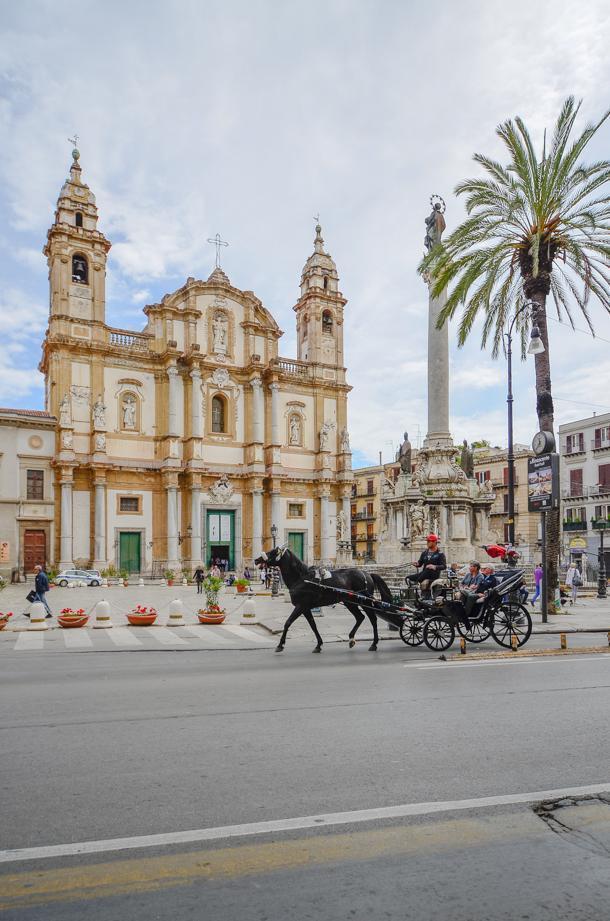
San Domenico Church, Palermo, Sicily
When I entered the church of San Domenico, the word cavernous came to mind, and rightly so, as it features huge ceilings and sombre stone columns. The interior is unpretentious, yet this was the location chosen for the burial of many famous Palermitani. One, in particular, is Giovanni Falcone, a judge and prosecuting magistrate who spent his entire career trying to overthrow the Sicilian Mafia. He was killed by the Corleonesi Mafia on May 23th, 1992, on the A29 autostrada, near the airport. The blast was so powerful it created a massive crater. Falcone was named a hero and was buried like one, and today his grave is covered by messages left by locals, praising him. This is how I know despite what you hear and see on TV, the people of Palermo, and Sicilians, in general, despise the existence of the Mafia and fight against it.
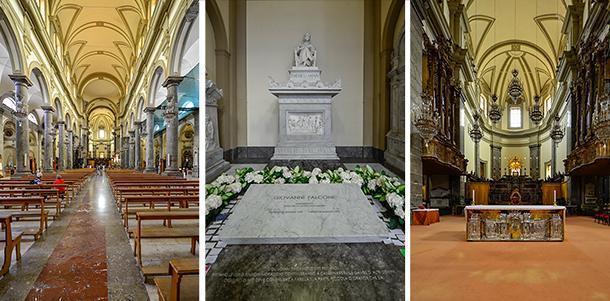
Inside the San Domenico Church, in Palermo, Sicily
Entrance to the church is free, but you will have to pay 2 euro/pers to see the cloister. Kids enter free.
2. Oratory of the Rosary of San Domenico
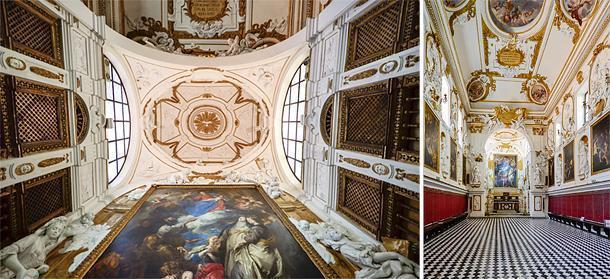
Oratory of the Rosary of San Domenico, Palermo
Around the corner from the church, you can find the Oratory of San Domenico. The Oratory contains beautiful stucco work by the Palermitano Giacomo Serpotta, an artisan who lived in this area of the city. Displayed here are twelve statues of virtues embodied as noblewomen. Twelve oil paintings featuring Jesus’ birth and death are protected by about twelve-hundred playful cherubs. Dominating the interior is Antony Van Dyke’s Madonna and St Dominic.
3. Oratory of Santa Cita
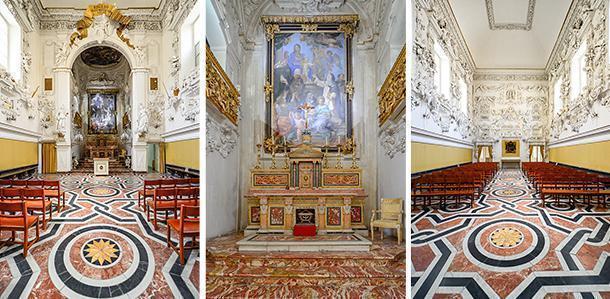
Oratory of Santa Cita, Palermo
Another masterpiece by Giacomo Serpotta, the Oratory of Santa Cita sits between tiny residential streets, not far from Vucciria, a busy local market. You could never tell the unassuming exterior of the Oratory is hiding the work displayed inside.
What impressed me the most is the entire work was created by a “nobody”. Serpotta was poor, and his dad died in prison, yet this is what a man of such humble beginnings was able to leave to history.
Entrance costs 6 euro/person, and it includes the Oratory of San Domenico. Kids enter free.
4. Zisa Palace
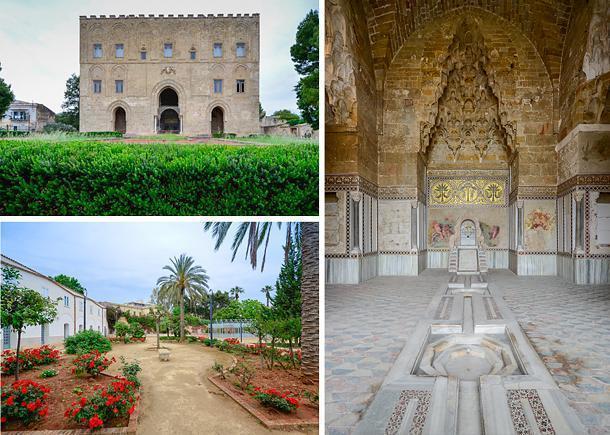
Zisa Palace, Palermo, Sicily
The Zisa Palace, built in the 12th-century, is one of the few remaining Arabic buildings in Palermo. Although it was commissioned by a Norman king, William I, it was built in the Arab tradition, and it served as a pleasure palace to indulge the king’s passions – hunting and women. Last year, the Palace was designated a UNESCO World Heritage Site. At the time of our visit, we were completely alone and were able to take our time exploring, including the outside gardens.
Entrance cost is 6 euro/person and kids enter free.
5. Pallazo dei Normani and the Palatine Chapel

The Norman Castle, Palermo, Sicily
As the oldest royal residence in Europe, the Pallazo dei Normani, or Norman Palace, was the seat of the Kings of Sicily, during Norman rule. Today it serves as the Seat of the Sicilian Parliament, and of the Sicilian Regional Assembly.
While the majority of the palace is worth visiting (the old Parliament room especially, called the Room of Hercules, displaying huge paintings representing the mythical hero in different positions of power, is quite impressive), the true gem of the palace is the Palatine Chapel. The chapel is by far the best example of the Arab-Norman-Byzantine style popular in 12th-century Sicily.

The Palatine Chapel, Palermo
The mosaic work is simply jaw-dropping, and this is not just me trying to find a cliché epithet, just watch the people going in, mouths open, and I was no different. The extremely elaborate mosaics, the wooden roof, elaborately fretted and painted, and the marble incrustation of the lower part of the walls and the floor makes this one of the most beautiful chapels I’ve ever visited.

The jaw-dropping mosaics of The Palatine Chapel, Palermo
Tip: DO NOT try to visit on a Saturday. This little chapel is used for local weddings, something we found out the hard way. Not being able to see the chapel the first day is the whole reason we returned to Palermo the second day. It’s simply unmissable. Photography is not permitted in the palace rooms and chapel and, although people were not taking photos of the rest of the palace, trying to stop them from photographing the chapel was futile.
Entrance to the palace, chapel, and a local art display, cost our family of four 24 euros, but there are cheaper options to see one or the other.
6. Palermo Cathedral
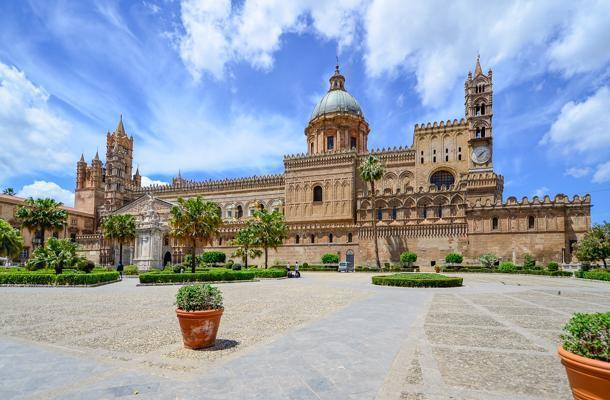
Palermo Cathedral, Sicily, Italy
In 1184, during Sicily’s Norman period, the Archbishop of Palermo founded the Palermo Cathedral on the former site of a Muslim mosque, which had was built over a Byzantine basilica. The archbishop’s primary goal was to surpass the glory of nearby Monreale Cathedral. Palermo Duomo was the architectural battleground of “The Battle of the Two Cathedrals.” For me, Monreale Duomo remains the winner, but Palermo’s cathedral is still well worth a visit.
Inside, the Duomo houses many tombs of Sicily’s kings. The chapel on the right contains the tomb of Roger II, the first king of Sicily, who was crowned here in 1130. Next to him are the remains of Roger’s daughter, Constance, and her husband, Henry VI, Emperor of Germany and son of Frederick Barbarossa, as well as their son, Frederick II, also emperor of Germany and king of Sicily, with his wife, Constance of Aragón. The last royal burial here was for Peter II, King of Sicily, in 1342.
Another point of interest is the Treasury, which contains vestments, chalices, silverware, but most notably, it houses the cap-like crown of Constance of Aragón, removed from the tomb when it was opened, in the 18th-century.

Inside Palermo Cathedral and up on the roof, Sicily, Italy
One nice feature of this cathedral is the ability to visit the roof. Do take the opportunity to go up and experience Palermo from a bird’s-eye view.
The ticket for the royal tombs, Treasury, the roof, as well as the crypt costs 7 euro/person. Kids pay nothing.
7. Quatro Canti
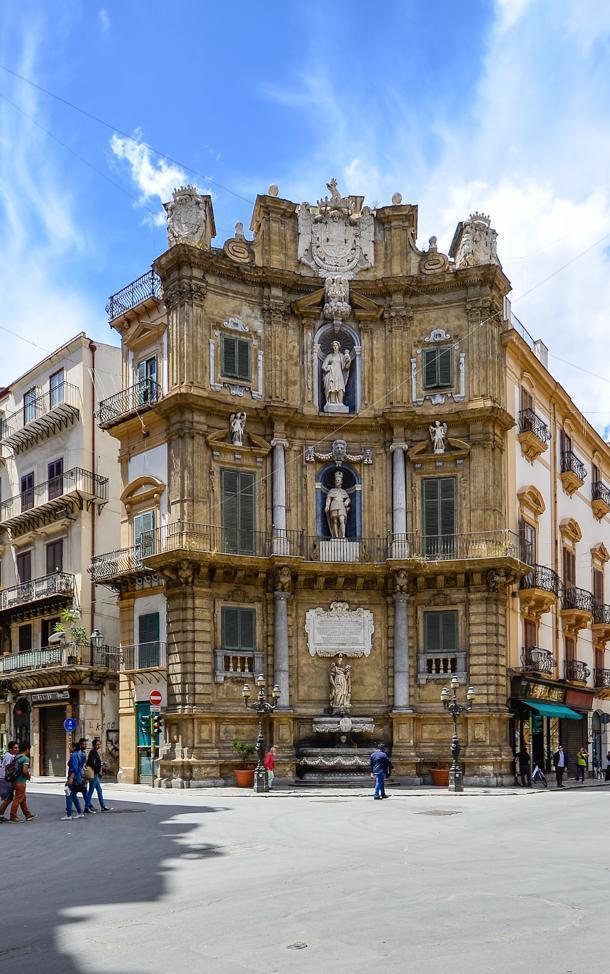
Piazza Vigliena, or Quatro Canti, Palermo, Sicily
Officially known as Piazza Vigliena, Quatro Canti is a Baroque square in Palermo where the four corners are Baroque buildings representing near-identical façades containing fountains with statues of the four seasons, and the four Spanish kings of Sicily.
Quatro Canti is a very busy intersection, do not venture to photograph it without paying close attention. Remember the hectic traffic I mentioned earlier.
8. Piazza Pretoria
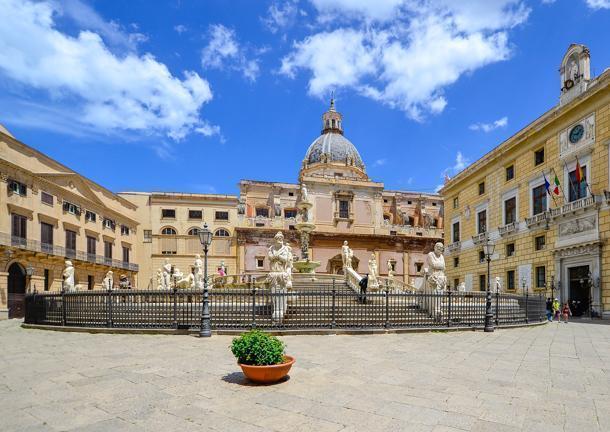
Piazza Pretoria is known as the Square of Shame, Palermo
Also known as the Square of Shame, Piazza Pretoria is just a few metres south of Quatro Canti. At the centre of this raised pedestrian square lays a sculpted fountain, initially made for a Florentine villa in the 1550s and rejected by its commissioners. Palermo bought this fountain and set it proudly in the city centre.
The residents, however, scandalised by the racy nude figures and lewd glances these statues were throwing each other across the water jets, promptly named it the Fontana della Vergogna or the Fountain of Shame, hence the nickname of the square.
9. Monreale Cathedral
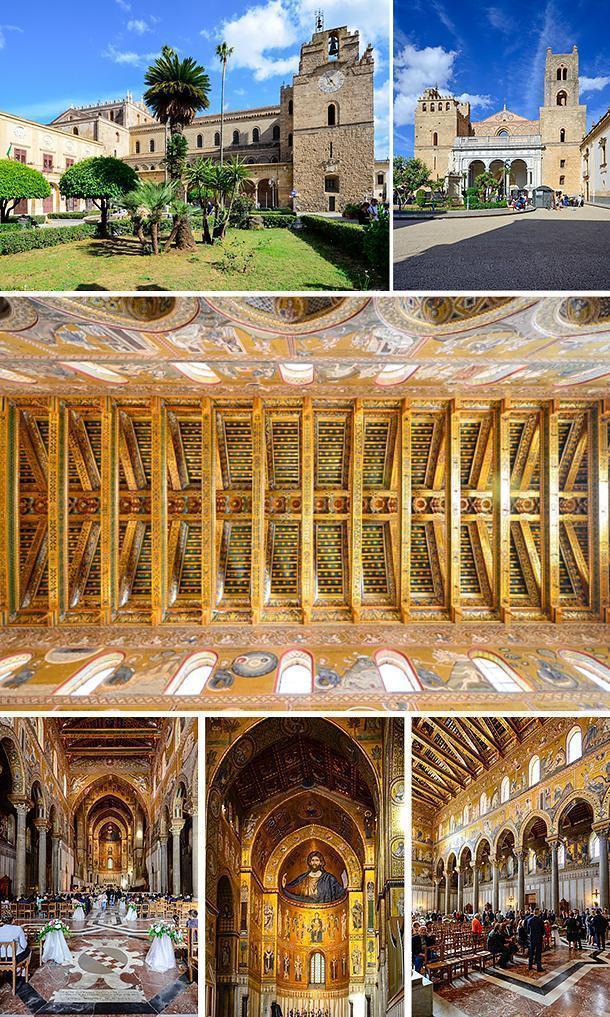
The stunning Monreale Cathedral, Sicily, Italy
No trip to Palermo is complete without a visit to Monreale, a suburb of Palermo, 8km away from the city centre. The Monreale Cathedral and its cloister represent the largest concentration of Norman, Arab and Byzantine art in one place. While Palermo’s cathedral is bigger, Monreale is closer to its original twelfth-century state. Although externally, most of Monreale Cathedral is not particularly striking, the splendid mosaics (covering the walls almost entirely) in the interior are its main attraction.

View from Monreale Cathedral, Sicily
Monreale is also known for its craft and artisan shops, specialising in ceramics and mosaics from Byzantine to Baroque, to folk, and even abstract. Monreale boasts some of the island’s best mosaic galleries. Two of which are on Via Arcivescovado behind the cathedral. Entrance is free of charge.
10. La Vucciria Market
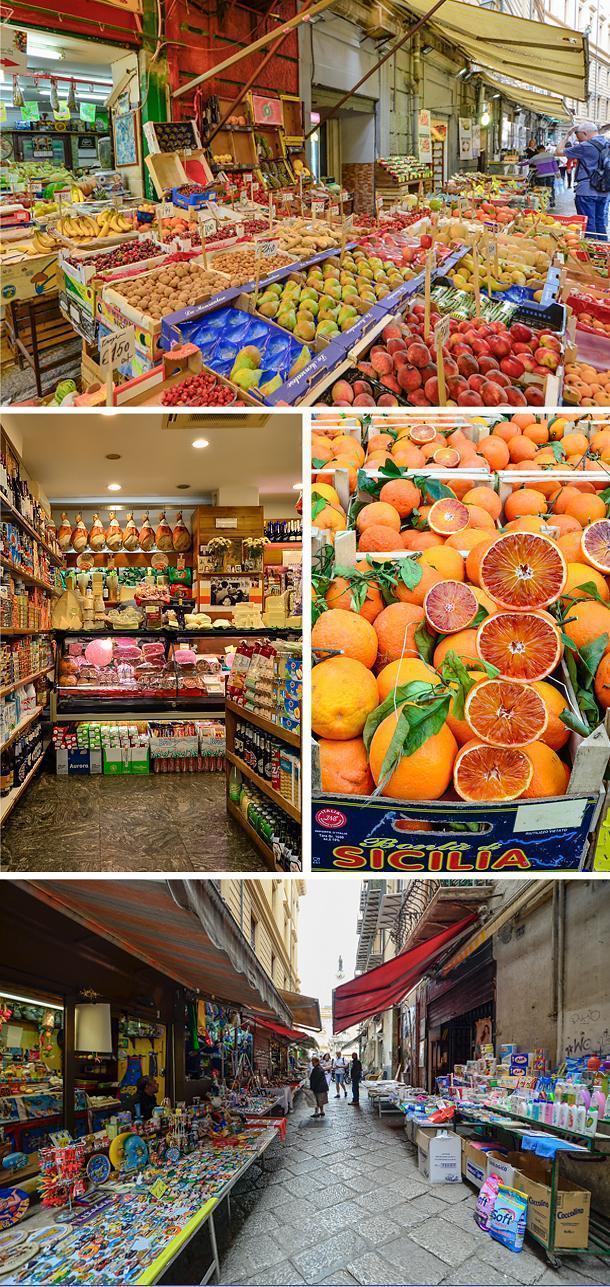
Vucciria’s colourful Market, Sicily, Italy
The colourful La Vucciria Market is considered the most famous market in Palermo, and it’s a mix of everything. Walk through the dense network of narrow streets and squares of Vucciria you can find all the ingredients of Sicilian cuisine. The diverse world of fish, resting on beds of crushed ice, is represented by shrimp, sea bream, scorpion fish, tuna, swordfish, octopus, cuttlefish, and squid.
Dipped in boiling pots are boiled octopus, seasoned and cooked to order with just a squeeze of lemon. The anchovies are cleaned before the eyes of customers.
Here you will also find stigghiole, a typical Sicilian dish, especially in Palermo. Its main ingredient is pig intestines cooked on the grill.
Vucciria has become one of the to go places for nightlife in Palermo. From the late afternoon into the night, you can find many bars selling drinks at a lower cost compared to other local areas and corners selling street food.
11. Ballaro Market
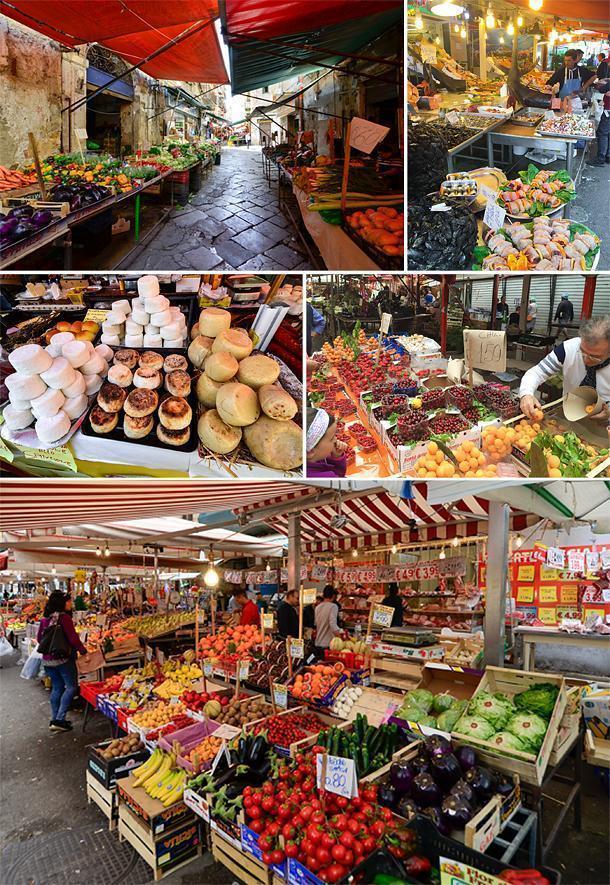
The vibrant Ballaro Market, Sicily, Italy
Probably my favourite place in Palermo, Ballaro is primarily a food market, and a street eater’s delight. I loved the noise, the song-like shouts of the vendors trying to draw you in, the smells, the food.
If you are renting an apartment and have the ability to cook, this is the place to buy your ingredients, as the prices are ridiculously affordable. You will not find markets cheaper than the ones in Sicily, all over Europe.
The vendors invite you to try different bites but do not feel obligated to accept. If you do, however, be prepared to pay for it as we found out with one of the vendors. He told us to try his wife’s ricotta cream puffs while buying fruit from him. He said not to be shy because they are free, and we ended up paying for them anyway. The whole encounter was so hilarious; I did not even protest.
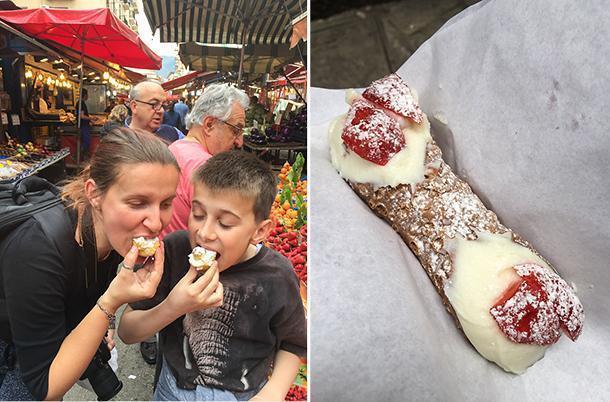
Free-not-free traets at the Ballaro Market, Sicily, Italy
Do not leave this market without eating at one of the street restaurants inside the markets. During the weekend it was busy, but they accommodated us just the same. They were as eager to sell their food as we were to eat it.
One last thing, do not leave without trying a cannolo, a Sicilian pastry dessert consisting of tube-like shells of fried dough, filled with a sweet, creamy filling of ricotta cheese and topped with fruit. My son ate his weight in cannolo during our stay in Sicily.
In Palermo, we found a bustling city chock full of history, culture, incredible architecture and good food. It is a city our entire family loved. If you wonder if you can travel there with kids, the answer is yes. Palermo and Sicily, in general, is kid-friendly with most venues free for children, and you will get no frowny faces when entering restaurants with them.
Sicily got under my skin and while I may have left with a couple of inches added to my waist, the joy I got from experiencing the island, more than likely, has added years to my life.
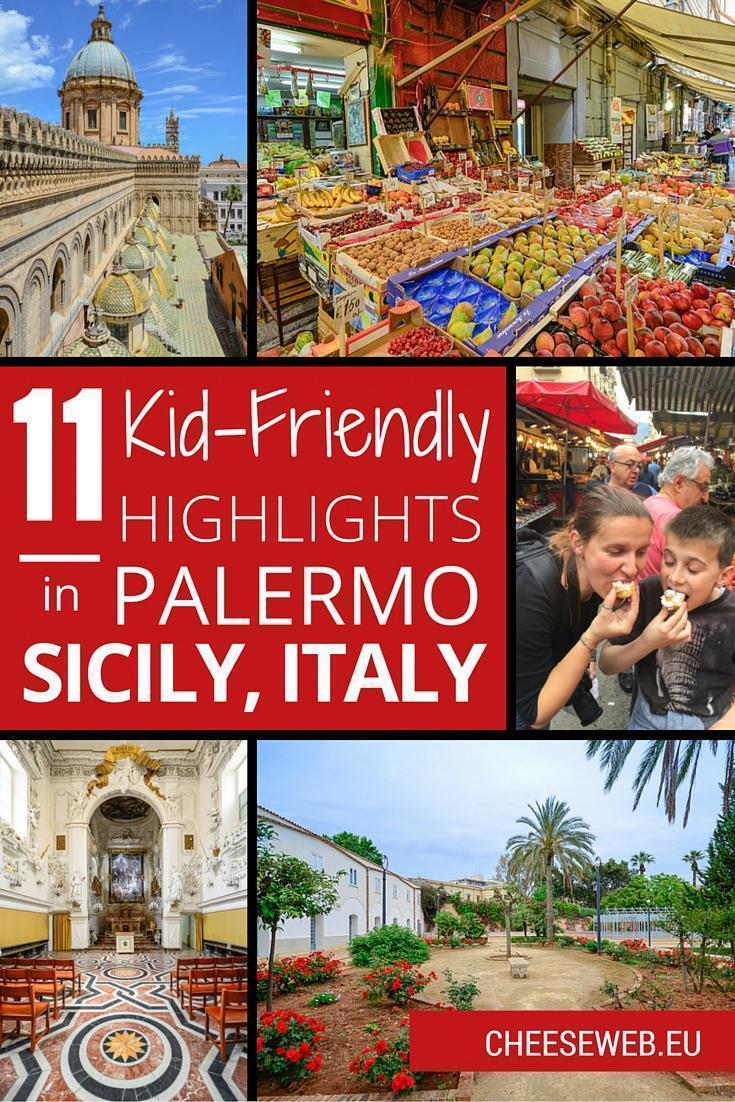
Like this article? Save it to Pinterest
- How to Spend 48 Hours in Kiev, Ukraine with kids - December 4, 2018
- The Best Things to Do in Sofia Bulgaria with Kids - October 24, 2018
- The Best Christmas Markets in Germany - October 13, 2018
